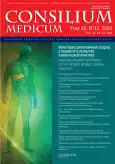Таргетная биопсия простаты в диагностике рака предстательной железы: результаты проспективного группового исследования
- Авторы: Окишев А.В.1, Говоров А.В.2, Васильев А.О.2, Садченко А.В.1, Колонтарев К.Б.2, Бормотин А.В.2, Ким Ю.А.1,2, Кузин Б.А.2,3, Рамазанов К.К.1,2, Пушкарь Д.Ю.2
-
Учреждения:
- ГБУЗ «Городская клиническая больница им. С.И. Спасокукоцкого» Департамента здравоохранения г. Москвы
- ФГБОУ ВО «Московский государственный медико-стоматологический университет им. А.И. Евдокимова» Минздрава России
- ФКУЗ «Медико-санитарная часть Министерства внутренних дел Российской Федерации по городу Москве»
- Выпуск: Том 22, № 12 (2020)
- Страницы: 69-73
- Раздел: Статьи
- URL: https://journals.rcsi.science/2075-1753/article/view/95388
- DOI: https://doi.org/10.26442/20751753.2020.12.200562
- ID: 95388
Цитировать
Полный текст
Аннотация
Ключевые слова
Полный текст
Открыть статью на сайте журналаОб авторах
Артем Вячеславович Окишев
ГБУЗ «Городская клиническая больница им. С.И. Спасокукоцкого» Департамента здравоохранения г. Москвы
Email: okishev.art@gmail.com
уролог Москва, Россия
Александр Викторович Говоров
ФГБОУ ВО «Московский государственный медико-стоматологический университет им. А.И. Евдокимова» Минздрава Россиид-р мед. наук, проф. каф. урологии Москва, Россия
Александр Олегович Васильев
ФГБОУ ВО «Московский государственный медико-стоматологический университет им. А.И. Евдокимова» Минздрава Россииканд. мед. наук, ассистент каф. урологии Москва, Россия
Антон Владимирович Садченко
ГБУЗ «Городская клиническая больница им. С.И. Спасокукоцкого» Департамента здравоохранения г. Москвыканд. мед. наук, уролог Москва, Россия
Константин Борисович Колонтарев
ФГБОУ ВО «Московский государственный медико-стоматологический университет им. А.И. Евдокимова» Минздрава Россиид-р мед. наук, проф. каф. урологии Москва, Россия
Алексей Владимирович Бормотин
ФГБОУ ВО «Московский государственный медико-стоматологический университет им. А.И. Евдокимова» Минздрава Россииканд. мед. наук, доц. каф. урологии Москва, Россия
Юрий Александрович Ким
ГБУЗ «Городская клиническая больница им. С.И. Спасокукоцкого» Департамента здравоохранения г. Москвы; ФГБОУ ВО «Московский государственный медико-стоматологический университет им. А.И. Евдокимова» Минздрава Россииаспирант каф. урологии Москва, Россия
Борис Александрович Кузин
ФГБОУ ВО «Московский государственный медико-стоматологический университет им. А.И. Евдокимова» Минздрава России; ФКУЗ «Медико-санитарная часть Министерства внутренних дел Российской Федерации по городу Москве»аспирант каф. урологии Москва, Россия
Керим Керимханович Рамазанов
ГБУЗ «Городская клиническая больница им. С.И. Спасокукоцкого» Департамента здравоохранения г. Москвы; ФГБОУ ВО «Московский государственный медико-стоматологический университет им. А.И. Евдокимова» Минздрава Россииаспирант каф. урологии Москва, Россия
Дмитрий Юрьевич Пушкарь
ФГБОУ ВО «Московский государственный медико-стоматологический университет им. А.И. Евдокимова» Минздрава Россииакад. РАН, д-р мед. наук, зав. каф. урологии Москва, Россия
Список литературы
- Available from: https://gco.iarc.fr/today/
- Available from: https://gco.iarc.fr/today/online-analysis-table
- Available from: https://gco.iarc.fr/tomorrow/graphic-line
- EAU-ESTRO-ESUR-SIOG Guidelines on Prostate Cancer. European Association of Urology 2019.
- Barentsz JO, Richenberg J, Clements R et al. ESUR prostate MR guidelines 2012. Eur Radiol 2012; 22:746-57.
- Weinreb JC, Barentsz JO, Choyke PL et al. PI-RADS Prostate Imaging - Reporting and Data System: 2015. Version 2. Eur Urol 2016; 69 (1): 16-40.
- Turkbey B et al. Prostate Imaging Reporting and Data System Version 2.1: 2019 Update of Prostate Imaging Reporting and Data System Version 2. Eur Urol 2019; 76 (3): 340-51.
- Thompson JE, Moses D, Shnier R et al. Multiparametric magnetic resonance imaging guided diagnostic biopsy detects significant prostate cancer and could reduce unnecessary biopsies and over detection: a prospective study. J Urol 2014; 192: 67-74.
- Rouviere O et al. Use of prostate systematic and targeted biopsy on the basis of multiparametric MRI in biopsy-naive patients (MRI-FIRST): a prospective, multicentre, paired diagnostic study. Lancet Oncol 2019; 20: 100.
- Kasivisvanathan V et al. MRI-Targeted or Standard Biopsy for Prostate-Cancer Diagnosis. N Engl J Med 2018; 378: 1767.
- Van der Leest M et al. Head-to-head Comparison of Transrectal Ultrasound-guided Prostate Biopsy Versus Multipara-metric Prostate Resonance Imaging with Subsequent Magnetic Resonance guided Biopsy in Biopsy-naive Men with Elevated Prostate-specific Antigen: A Large Prospective Multicenter Clinical Study. Eur Urol 2019; 75: 570.
- Braeckman J, Autier P, Garbar C et al. Computer-aided ultrasonography (HistoScanning): a novel technology for locating and characterizing prostate cancer. BJU Int 2008; 101: 293-8.
- Javed S, Chadwick E, Edwards AA et al. Does prostate HistoScanningTM play a role in detecting prostate cancer in routine clinical practice? Results from three independent studies. BJU Int 2014; 114 (4): 541-8.
Дополнительные файлы






